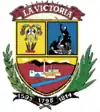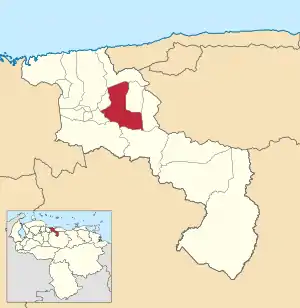José Félix Ribas Municipality
Municipio José Félix Ribas | |
|---|---|
 Flag  Seal | |
 Location in Aragua | |
.svg.png.webp) José Félix Ribas Municipality Location in Venezuela | |
| Coordinates: 10°12′07″N 67°19′47″W / 10.2020833°N 67.3297126°W | |
| Country | |
| State | Aragua |
| Municipal seat | La Victoria |
| Government | |
| • Mayor | Juan Carlos Sánchez (PSUV) |
| Area | |
| • Total | 387.3 km2 (149.5 sq mi) |
| Population (2011) | |
| • Total | 143,501 |
| • Density | 370/km2 (960/sq mi) |
| Time zone | UTC−4 (VET) |
| Area code(s) | 0244 |
The José Félix Ribas Municipality is one of the 18 municipalities (municipios) that makes up the Venezuelan state of Aragua and, according to the 2011 census by the National Institute of Statistics of Venezuela, the municipality has a population of 143,501. [1] The town of La Victoria is the shire town of the José Félix Ribas Municipality.[2]
History
La Victoria is famous for the independence battle of February 12, 1814, where José Félix Ribas led a young and inexperienced army that succeeded in halting the royalist troops of José Tomás Boves. Venezuela celebrates "Youth Day" every February 12 in La Victoria, with a ceremony is usually presided by the President of the Republic.
Demographics
The José Félix Ribas Municipality, according to a 2007 population estimate by the National Institute of Statistics of Venezuela, has a population of 156,139 (up from 137,581 in 2000). This amounts to 9.3% of the state's population.[3] The municipality's population density is 372.65 inhabitants per square kilometre (965.2/sq mi).[4]
Government
The mayor of the José Félix Ribas Municipality is Juan Carlos Sánchez, elected on November 23, 2008, with 48% of the vote.[5] He replaced Rosa León Brabo shortly after the elections. The municipality is divided into five parishes; Capital José Félix Ribas, Castor Nieves Ríos, Las Guacamayas, Pao de Zárate, and Zuata.[2]
See also
References
- ↑ "GeoHive - Venezuela extended population statistics". Archived from the original on 2016-03-15. Retrieved 2016-06-15.
- 1 2
- ↑
- ↑
- ↑ "Divulgación Elecciones Regionales - 23 de Noviembre de 2008". www.cne.gob.ve.
External links
- josefelixribas-aragua.gov.ve (in Spanish)